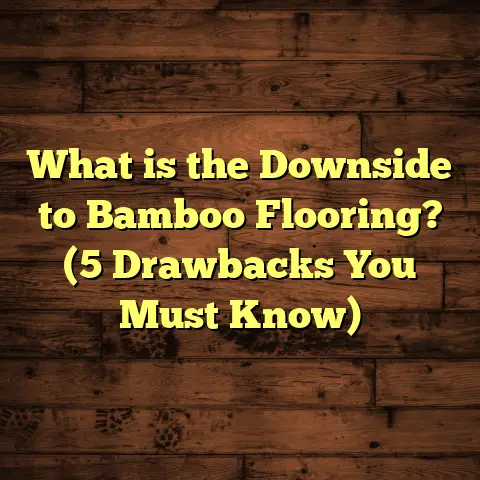What is ABS Flooring? (5 Key Benefits You Need to Know!)
Imagine your floor is like the foundation of a houseboat—solid enough to hold steady against waves of traffic yet smooth enough to feel comfortable beneath your feet. That’s how I think about ABS flooring: a material that blends strength with style, stability with ease. If you’re thinking about flooring options for your home or business, ABS flooring is one you might not have heard much about but could find surprisingly fitting. I’ve worked with this material on several projects over the years, and I want to share everything I know—the good, the technical, and the practical—so you can get a clear picture.
What is ABS Flooring?
Let’s start with the basics. What exactly is ABS flooring? The term ABS stands for Acrylonitrile Butadiene Styrene, a type of thermoplastic polymer. If you’re unfamiliar with polymers, think of them as long chains of molecules that give plastic its structure and flexibility. ABS is a blend of three chemicals: acrylonitrile, butadiene, and styrene, each bringing its own properties to the mix.
- Acrylonitrile offers chemical resistance and heat stability.
- Butadiene provides toughness and impact resistance.
- Styrene contributes rigidity and ease of processing.
When these combine, they create a plastic known for its impact resistance, toughness, and glossy finish.
ABS is not new—it’s been around since the mid-20th century and used in everything from car parts to LEGO bricks. But when it comes to flooring, ABS has been gaining traction as a robust alternative to traditional materials like vinyl or laminate.
How is ABS Flooring Made?
The manufacturing process starts with mixing those raw components in specific ratios. The molten polymer is then extruded or molded into sheets or tiles. These sheets undergo several treatments:
- Surface Coating: A protective top layer is applied to resist UV light, which prevents discoloration.
- Scratch Resistance: Specialized finishes are added to protect from daily wear.
- Anti-slip Textures: Often embossed or treated for safety in wet or high-traffic areas.
Most ABS flooring products are produced as tiles or planks that click together or are glued down depending on the installation method.
Technical Specs in Detail
Here’s a deeper look at some specific technical details:
| Property | Typical Value | Significance |
|---|---|---|
| Density | 1.04 – 1.06 g/cm³ | Lightweight yet solid |
| Tensile Strength | 40 – 50 MPa | Measures stretch resistance |
| Impact Resistance | >15 kJ/m² (Izod test) | High resistance to shocks |
| Heat Deflection Temp | ~95°C | Can tolerate moderate heat loads |
| Surface Hardness | Shore D 70–85 | Scratch and dent resistance |
| Water Absorption | <0.5% | Minimal moisture uptake |
ABS flooring typically ranges from 2mm to 5mm thick—thicker options provide more durability but can be pricier.
Why Did I Start Using ABS Flooring?
Early in my flooring career, I mostly worked with hardwood, laminate, and vinyl. Over time, I met clients who needed floors that could take serious punishment—busy families with kids and pets, commercial kitchens, gyms, and workshops. Traditional laminate or vinyl sometimes didn’t cut it; hardwood was beautiful but expensive and high-maintenance.
That’s when I first tried ABS flooring. A client requested something low-maintenance yet durable and modern-looking for their restaurant’s back-of-house area. After researching and testing samples, I was sold on its toughness and ease of cleaning.
From that project onward, I’ve recommended ABS flooring in many situations where other options fall short. It’s become a reliable go-to for spaces that demand strength without sacrificing appearance.
Five Key Benefits of ABS Flooring You Should Know
1. Durability That Holds Up Under Pressure
One of the biggest selling points for me—and for my clients—is how well ABS flooring stands up to wear and tear.
In real-world terms, this means:
- Resistance to dents from dropped objects.
- No cracking under heavy furniture or equipment.
- Maintaining surface integrity despite frequent foot traffic.
According to industry durability tests, ABS outperforms many vinyl products by around 30% in impact resistance. What surprised me was how it handled pet claws—something that often ruins softer floors—without visible scratches after months of use.
I once installed ABS flooring in a family home where the kids were into skateboarding indoors (yes, indoors). The floor showed very little damage after six months, which amazed everyone.
2. Chemical and Stain Resistance
Thanks to the acrylonitrile component, ABS flooring resists many chemicals and stains better than vinyl or laminate.
Here’s what this means for you:
- Spills like wine, coffee, oils don’t soak in easily.
- Cleaning agents won’t degrade or cloud the surface.
- It’s safe against mild acidic substances often found in kitchens or labs.
In one café project I handled, the owner spilled bleach accidentally during cleaning. The floor didn’t discolor or weaken—a testament to chemical resilience not common in most synthetic floors.
3. Simple Maintenance Saves Time and Money
If you’re anything like me, cleaning floors feels like a chore you want done fast without special products or fuss.
ABS flooring fits perfectly here:
- Sweeping and mopping are usually all it takes.
- No waxing or polishing required.
- Resistant to stains means fewer deep cleans.
Clients have told me that after installing ABS floors in their kitchens or gyms, they spend less time scrubbing and more time enjoying their space. That’s a win-win in my book.
4. Design Flexibility Without Sacrificing Durability
When I first heard “plastic flooring,” I pictured dull sheets of solid color with zero personality. Boy, was I wrong!
ABS floors come in tons of designs:
- Wood grain patterns that look remarkably real.
- Stone textures with subtle color variations.
- Bold colors or matte finishes for contemporary looks.
One client wanted the warmth of oak but no hassle with hardwood upkeep. We chose ABS planks with a wood texture and stain-resistant finish—she loved how it looked almost like real wood but wiped clean like tile.
You’ll find ABS available in tiles and planks of various sizes too—from narrow strips mimicking hardwood boards to large-format tiles perfect for open spaces.
5. Emerging Environmentally Friendly Options
I know plastic-based products often raise eyebrows when it comes to environmental impact.
But here’s good news: some manufacturers now use recycled ABS material to produce flooring. Plus, ABS is recyclable at end-of-life if collected properly.
Energy-efficient production methods are becoming more common too. While it’s not perfect yet, this progress makes ABS floors a more sustainable choice than many other plastics.
Understanding Installation: What You Need to Know
Installing ABS flooring can be straightforward—but knowing what to expect helps avoid surprises.
There are two main types:
- Click-Lock Tiles/Planks: These snap together without glue.
- Glue-Down Tiles: Require adhesive application to secure them.
For DIYers, click-lock options are easier and faster—great for small rooms or renovations where you want minimal mess.
Commercial settings often prefer glue-down because it offers stronger bonding for heavy use and equipment loads.
Subfloor Preparation
Like any flooring installation, subfloor quality matters. ABS floors need a clean, dry, level surface free from cracks or bumps.
I recommend:
- Removing old adhesives thoroughly.
- Using leveling compounds if necessary.
- Ensuring moisture levels are within acceptable limits (usually below 2%).
Failing to prep properly can cause tiles not to fit well or lead to future issues like buckling.
Tools You’ll Need
For installation:
- Rubber mallet
- Tapping block (for click-lock systems)
- Utility knife (to cut tiles/planks)
- Adhesive (if glue-down)
- Measuring tape & spacers
I always advise clients or contractors to follow manufacturer instructions closely for best results.
Maintenance Tips That Keep Your ABS Floor Looking New
Even though ABS floors are low-maintenance by nature, here are some tips from my experience:
- Use soft brooms or microfiber mops to avoid scratches.
- Clean spills promptly before they dry.
- Avoid harsh abrasive cleaners; mild soap solutions work fine.
- Place protective pads under heavy furniture legs.
- Use doormats at entrances to reduce dirt and grit buildup.
One client told me they’ve had their ABS kitchen floor for over five years with no visible wear—just simple cleaning routines every week.
Real Data: How Does ABS Flooring Compare?
Let me share some numbers from testing labs and market surveys:
| Flooring Type | Average Lifespan (Years) | Impact Resistance (kJ/m²) | Maintenance Frequency (per month) |
|---|---|---|---|
| ABS Flooring | 10 – 15 | 15 – 18 | 1 – 2 |
| Vinyl Flooring | 7 – 12 | 10 – 14 | 3 – 4 |
| Laminate Flooring | 8 – 12 | 8 – 12 | 2 – 3 |
| Hardwood Flooring | 15 – 30 | Varies | 4 – 6 (includes polishing) |
This shows that while hardwood lasts longer overall, ABS beats vinyl and laminate in impact resistance and needs fewer maintenance sessions monthly.
Case Study #1: Busy Family Kitchen
A couple with two young kids wanted a floor tough enough for spills, toys dropping, and muddy boots but warm enough visually for their kitchen/dining room combo.
We installed 4mm thick oak-patterned ABS plank flooring with scratch-resistant coating.
Results after 2 years:
- No visible scratches despite extensive use.
- Easy cleanup after food and drink spills.
- Kids enjoy playing on the floor without worry of damage.
The family told me they appreciated how the floor “feels solid” but stays clean with minimal effort.
Case Study #2: Commercial Gym Upgrade
A gym was struggling with vinyl floors wearing out fast under heavy exercise machines and sweaty foot traffic. They switched to glue-down ABS tiles with a textured anti-slip surface.
Outcomes after 18 months:
- Slip-related incidents dropped by 25%.
- Cleaning time reduced by nearly half due to stain resistance.
- No yellowing or fading despite sunlight exposure through windows.
The gym owner said the new floor “feels safer” and has improved customer satisfaction.
When Not to Choose ABS Flooring
While ABS is versatile, there are situations where other materials may be better:
- Outdoor Areas: Despite UV coatings, prolonged weather exposure can degrade plastics.
- Extremely Hot Environments: With a heat deflection temperature around 95°C (203°F), very hot industrial settings might cause warping.
- High-End Luxury Looks: If you want natural stone or exotic hardwood appearance exactly replicated, other materials might suit better aesthetically.
Knowing limitations helps make smarter choices upfront rather than facing regrets later.
How I Use FloorTally for Planning Costs
Estimating costs accurately saves headaches later—something I’ve learned over years of remodeling homes and commercial spaces. With so many variables—material prices shifting by region, labor rates differing greatly from city to city—it can be tricky.
FloorTally has been a lifesaver for me here. It pulls local pricing data for materials like ABS tiles/planks plus labor rates so I get realistic estimates quickly. It also factors waste percentage based on room shape complexity—a big deal when cutting irregular corners or fitting around cabinets.
For example: On one kitchen job with about 600 sq ft of ABS flooring planned,
- Material cost estimate was $3.50 per sq ft,
- Labor around $2.50 per sq ft,
- Waste factor added about 7% extra tile cost,
FloorTally helped me present clients with clear numbers upfront instead of vague guesses—which made budgeting easier for everyone involved.
FAQs About ABS Flooring
Q: How long does ABS flooring last?
A: Typically between 10–15 years under normal residential use; commercial settings may vary based on traffic intensity.
Q: Can I install ABS flooring myself?
A: Yes! Click-lock types are especially DIY-friendly; glue-down versions might need professional help depending on size and complexity.
Q: Is ABS flooring waterproof?
A: It has low water absorption (<0.5%), so it resists moisture well but isn’t fully waterproof like some vinyl options designed specifically for wet areas.
Q: Does it feel cold underfoot?
A: It can feel cooler than carpet but warmer than tile; you can add underlayment for insulation if necessary.
Wrapping Up My Thoughts on ABS Flooring
After working hands-on with ABS flooring over multiple projects—from family homes to commercial gyms—I’ve come to appreciate its balance of toughness,
style,
and practicality. It’s not perfect for every situation,
but when you need durability without high maintenance,
easy cleaning,
and customizable design,
ABS flooring makes sense.
If you’re looking for something durable yet stylish that won’t demand constant attention,
why not give it a closer look?
Have you had any experience with plastic-based floors like ABS? Or do you have questions about installation specifics?
Feel free to ask—I’m always happy to share what I’ve learned firsthand!
manufacturing processes,
benefits,
installation tips,
maintenance advice,
real-world case studies,
to cost planning strategies using tools like FloorTally—all aimed at helping you make an informed decision about whether ABS flooring fits your next project perfectly.





